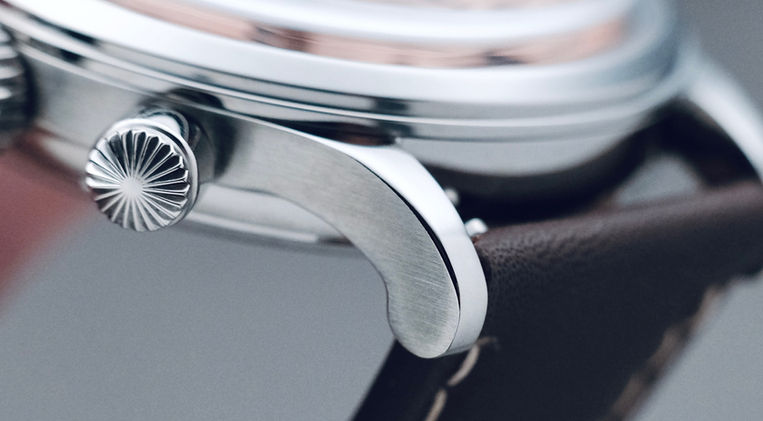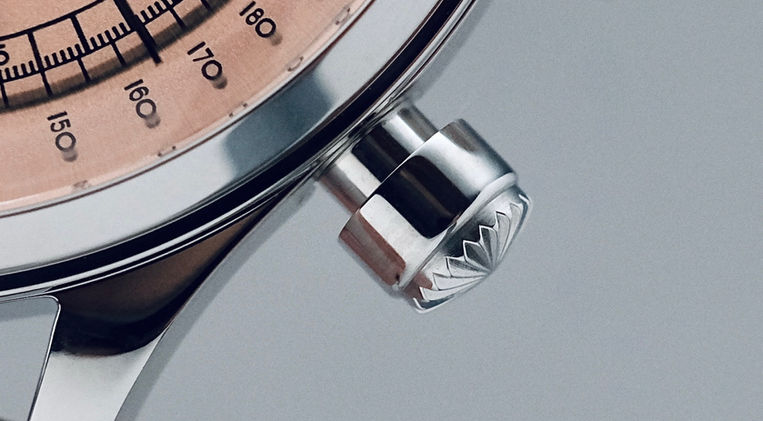Anders & Co AC1 Chronograph Rose
A Bridge to a Vision of Horology
July 8, 2025
by Vincent Deschamps
There is no shortage of dual-register meca-quartz chronographs on the market today. Let’s be real, alright? And some of them have attained fame and won awards, while some others have remained unknown. And brands continue to make these watches although many enthusiasts and collectors express their frustration to seeing yet again a dual-register mecaquartz chronograph being brought to the market. “We don’t need them” they say. “Again with the Seiko VK64 movement” they growl. Maybe they say so because one of them did become ubiquitous really fast and for no apparent reason. And that one didn’t do anything revolutionary, at least not mechanically, and visually is equal to many other similar watches. And do you know what all of this makes me think of? Skin divers. They were hundreds of them made starting in the early 1960s and they all pretty much looked the same. So they were as popular popular then as mecaquartz chronographs are popular today.
Saying that such and such brand shouldn’t make yet another meca chrono is akin to saying that such and such car manufacturers shouldn’t make electric cars or that such and such fashion brands shouldn't make oversized pants. (I mean, WTF?) I don’t get why people get angry at such things. Don’t they have way better things to do? If a brand wants to make mecaquartz chronographs. then let them. If enthusiasts want to buy them, let them. Because I believe that it is by revisiting previous designs and genre of watches—and re-interpretating them through a new personal lens—that the industry continues to thrive and be well. Often times a brand needs to start with something we feel familiar with before moving onto something we aren’t be familiar with. And that’s exactly what Anders & Co is doing through the AC1 Chronograph and as it will through the AC2 Volcán. So let’s talk about yet another mecaquartz chronograph today because they matter.

Specifications
Spoiler alert: the AC1 is powered by a Seiko VK64 mecaquartz chronograph movement! A very popular caliber with a stated accuracy of +/- 20 seconds per month and a battery life of more or less three years. In one of the numerous reviews I’ve written about VK64-powered watches, I noted that brands chose this movement for its extraordinary specs—to-price ratio, in other words, its superb value. Many enthusiasts and collectors mourn the 24-hour indicator at the three o’clock which I agree isn’t useful, but it makes it possible to have a dual-register layout which has inspired the creation of the AC1*. (Anders & Co, like many others, sought to recreate a particular type of vintage timekeeping device which is endowed with magnificent charm and class.) And to reach this goal and match the movement inside, the brand chose to keep the AC1 relatively compact and nimble: 38mm in diameter, 46mm lug-to-lug, 11.5mm thick, and a 20mm lug width.

The additional advantage of opting for the VK64 is the everyday reliability that it comes with. The AC1 was designed to be a reliable and well-crafted timepiece for everyday use and functionality (quoting from the Anders & Co’s website) and that’s indeed what we have here. The solid caliber is paired with double-dome sapphire crystal with sevelar layers of inner anti-reflective coating, 30 meters of water resistance, deeply-knurled push/pull crown and chronograph pushers, and a partially polished 316L stainless steel case. The pushers have conical tips and a drill-bit like knurling on their outside which looks fantastic and adds to the pleasure of using the mechanical-actuated chronograph functionality. The finishing of the case is particularly nice and soft to the touch, the leather strap is thick and feels robust, and is paired to a fully brushed and branded buckle. Putting the movement, crystal, case and crown/pushers finishing together, the asking price of $634 already seems appropriate.

*I would add that quality and reliable dual-register mechanical chronograph movements, which would be the ideal choice for this type of watch, are much more difficult and expensive to acquire.

Design
Dual-register chronographs have been popular for close to a century and came in many shapes and forms. And one style brands like to bring back is that of early 1940s through 1960s elegant machines which did have two sub-registers and different dial layouts and the absence of lumed elements. (These were not tool watches but everyday watches.) There are honestly too many relevant vintage references to choose from as the potential basis for the design of the Anders & Co AC1 Chronograph, but what is certain is that the brand aimed at blending together several vintage models whilst endowing their version of it with modern technology and contemporary means of manufacturing. And the first element of its design we will linger on is the dial color: Rose as the brand calls it which to me looks like copper-salmon on which was sprinkled gold dust. The dial has depth and reflects light in subtle and elegant ways and deserves your closest of inspections.

The pearlescent dial finish occupies the entirety of its surface and looks splendid as the background for the multiple sectors organizing the various types of information we need to process and digest. First we see the blacked-out and matte hands, leaf-shaped for the hour and minute ones, needle-shaped for the chronograph hand, powerfully contrasting with the dial. North and south of it we find “12” and “6” applied and designed in the style of Breguet numerals, and applied batons everywhere else except for the three and nine, spaces occupied by the sub-registers. The two sub-registers are decorated with a radial texture, small leaf-shaped and blacked-out hands, and a combination of small hash-marks and numerals to make it easier to read the information printed on it. Beyond the hour markers we find several sectors encompassing the minute track and lastly, a tachymeter scale printed at the outer ages of the dial. Definitely then a classic dual-register chronograph layout.

The classicism of the Anders & Co AC1 chronograph aesthetic continues onto the case. And you might be familiar with what we’re about to look at, should you have a knack for this era of horology. Mainly a step-case construction where the fully polished bezel is designed on two levels, however here pushed to its outer edges which make it subtle and elegant. Long and narrow lugs which turn down towards the wrist and are perfectly rounded at their tip. An extremely narrow case made even more so thanks to the polished edges of the case-back, and an otherwise flat middle case-back section that screws down. Lastly, the step-construction of the bezel leads to the double-domed sapphire crystal whose curvature is matched by that of the bezel design. Therefore, seen from the side and from above, the AC1 Chronograph is powerfully elegant and classic, and makes for a delight to wear on the wrist.

The Heart of the Matter
Indeed, the Anders & Co AC1 Chronograph Rose truly is a mixture of various vintage dual-register chronographs references. And as we know, we’ve seen quite a few affordable and modern reinterpretations of them popping on the micro/independent watch market in the past couple of years. There are dirt cheap versions of them sold on AliExpress and more expensive versions of them made of the same stuff and coming with similar dimensions and prices as the AC1. So why make it? The short answer is “why not?” Some of you might think that the AC1 is just another mecaquartz-chronograph and that we have enough of them already. And you think so because there is one particular brand that won a GPHG award for making a similarly priced and spec’ed and looking timekeeping device and so why bother? What is the intrinsic value of making yet another meca chrono since we already have so many of them? These are legitimate questions I will try to answer.

The way I see it is twofold. First, Anders & Co has the same rights as any other brand, young or old, with heritage or not, to make anything they wish to make. Remember that watches aren’t objects we need. They are objects we want to have for multiple reasons—self-expression, to commemorate an event, or to give us the strength to become who we aspire to be. They are also means of artistic expression in the same ways as clothing, cars, and interior decor are. So Anders & Co has the right to express itself, its vision for horology. Second, by making the AC1 Chronograph, Anders & Co is contributing to resurgence and appreciation of a certain horological aesthetic which otherwise would be dead and gone. The more brands make a certain type of watch, the more likely it is to remain within the canon of watch design. And the truth about mankind is that we do things in cycles and so it was to be expected that this type of watch would make a comeback.

Conclusion
The Anders & Co AC1 Chronograph is two things: a comfortable, elegant, and reliable everyday timepiece which you can acquire for $634 USD in one of two colors. (There are a total of four but two are sold out.) It is also a nod to a period of watch design which was crucial to the industry in that it shaped how many watches would become and how certain brands would impact our niche world for decades to come. Moreover, it represents the passion the brand’s founders have for a certain type of horology which is long gone, but which is making a slow comeback, allowing them to contribute to the health and wealth of the watch industry in a way that is uniquely theirs and, as I hope it to be, for decades to come. As mentioned in the introduction, after the AC1 Chronograph, Anders & Co is already working on something special which I hope will further cement the brand’s growing presence on the market.
Thanks for reading.








































